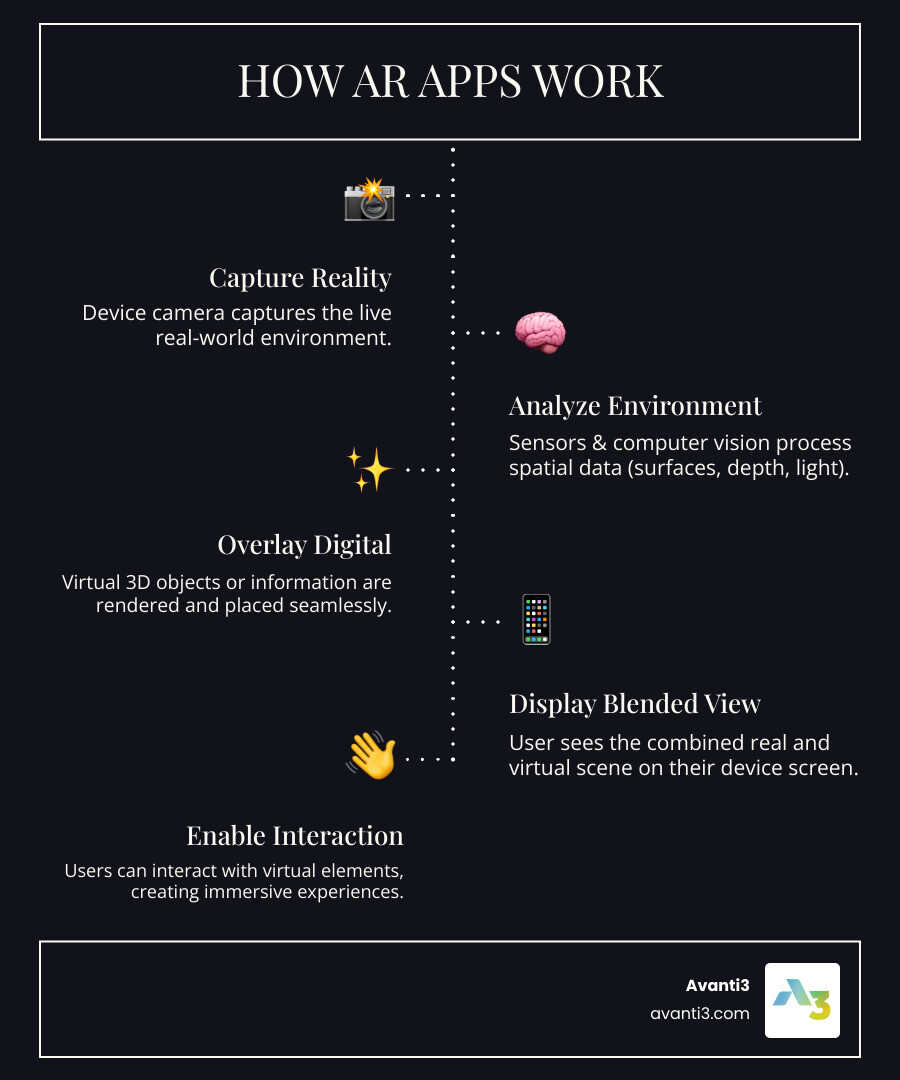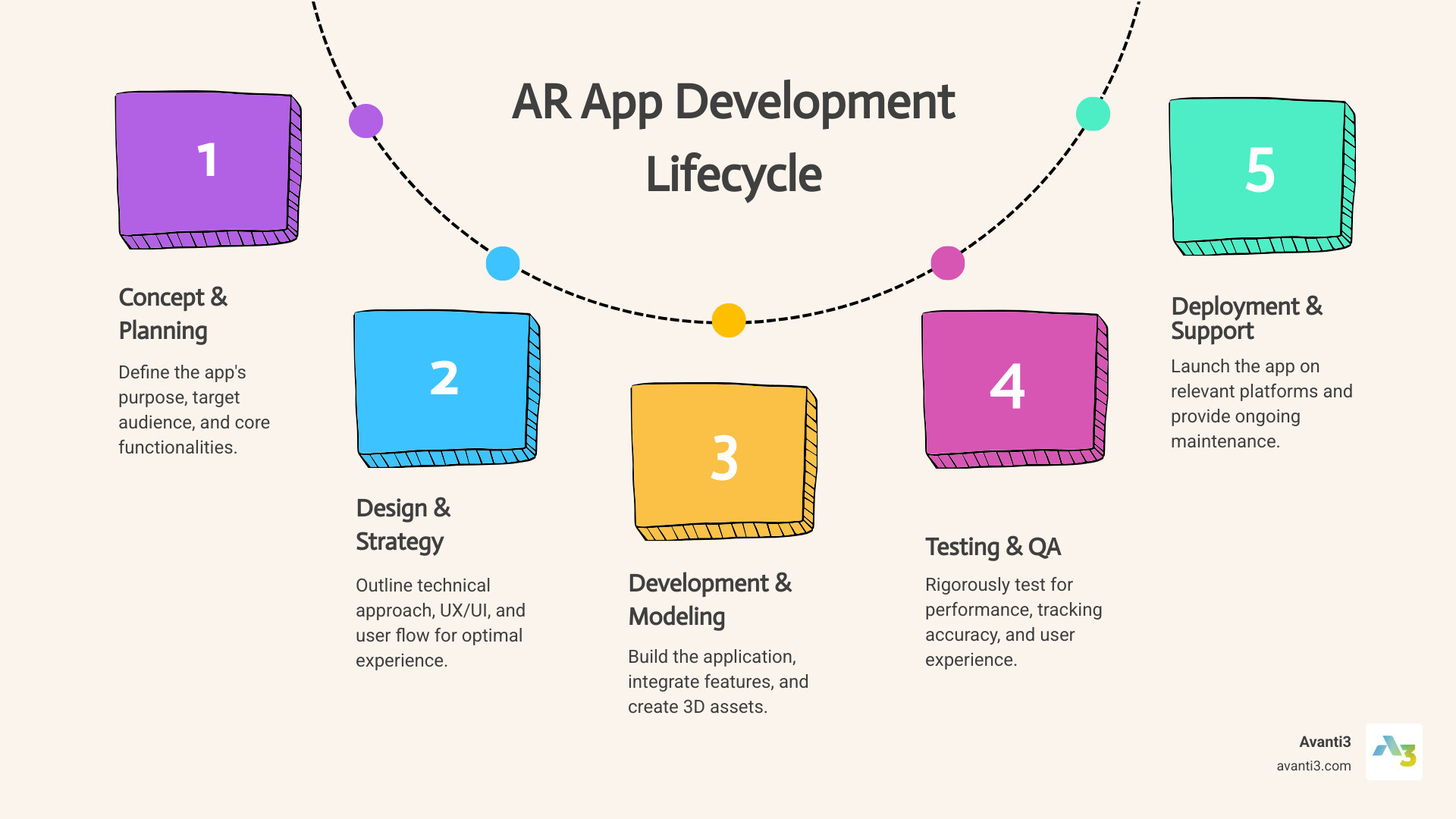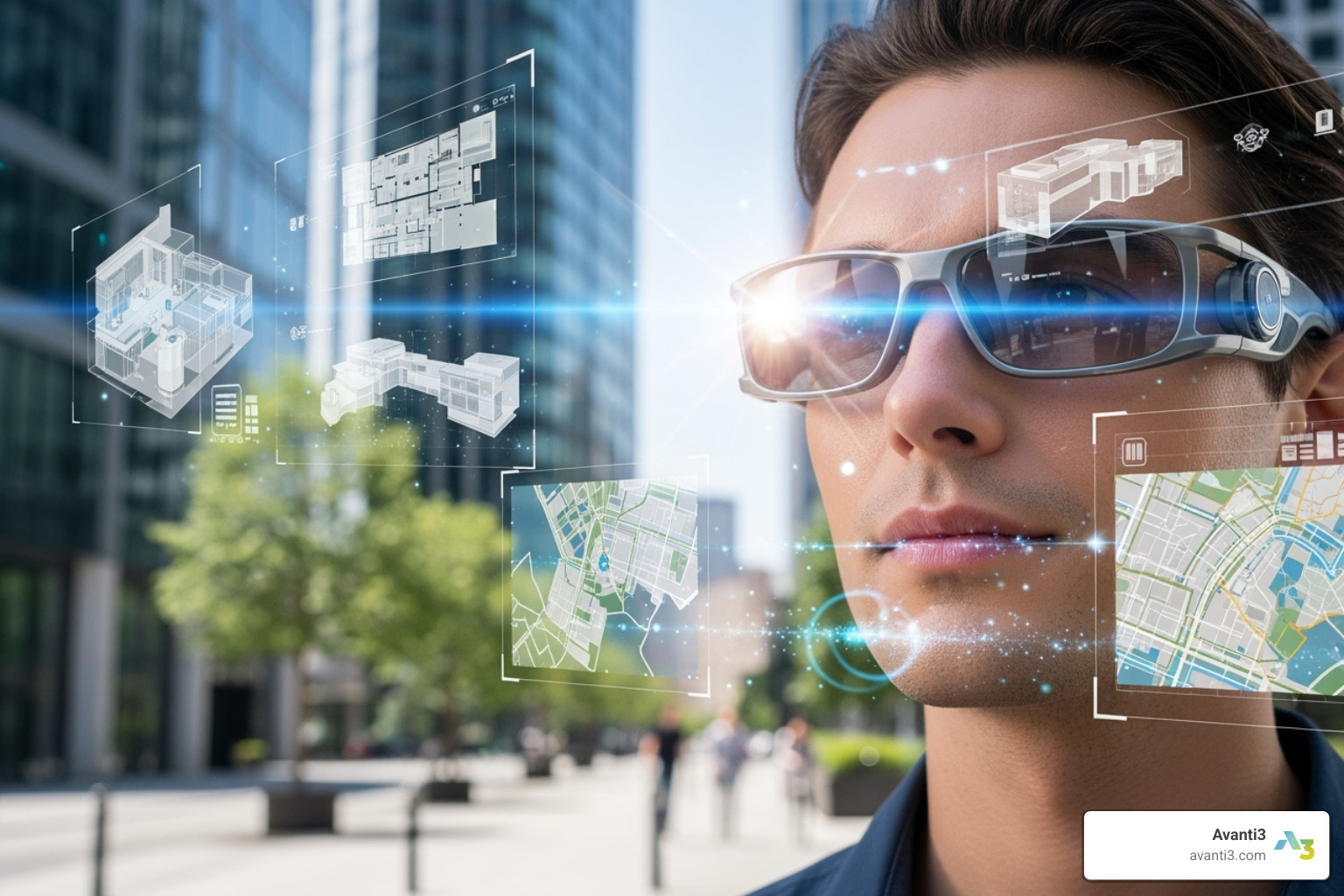AR Apps Development: 7 Steps, Zero to Hero
Explaining Augmented Reality App Development
Looking for a quick answer on AR apps development? Here’s the core idea:
- AR apps development involves creating software that overlays digital information onto the real world.
- This technology uses your device’s camera and sensors to blend virtual objects seamlessly into real-world environments.
- The goal is to improve user interaction and provide engaging, immersive experiences without fully replacing reality.
AR apps development is rapidly changing how we interact with technology. What once seemed like science fiction is now an everyday reality for millions, ever since games like Pokémon Go showed us the magic of augmented reality back in 2016.
Today, AR is revolutionizing how we shop, learn, train, and even receive healthcare, signaling a massive and growing market.
As an entrepreneur and marketing expert, I’ve seen how AR apps development transforms businesses. In this guide, we’ll break down everything you need to know about building your own augmented reality applications.

Simple guide to ar apps development terms:
What is Augmented Reality and Why Does It Matter?
Augmented Reality (AR) is technology that places digital information—like 3D models or data—onto your view of the real world. Unlike Virtual Reality (VR), which creates a completely artificial world, AR improves your current reality, making it more interactive.
How does it work? Your device’s camera and sensors use Simultaneous Localization and Mapping (SLAM) to map the environment and track its own position within it. This ensures virtual objects remain fixed in place as you move. Advanced computer vision helps the app recognize surfaces like floors and walls, allowing for seamless integration.
For businesses, AR is a powerful engagement tool. Interactive experiences, like previewing furniture in a room, boost customer excitement and confidence. A NielsenIQ survey found 61% of shoppers prefer stores with AR, and 56% felt more confident in their purchases because of it. Businesses using ar apps development are seen as innovative leaders.
Types of AR Applications and Industry Use Cases
AR can be used in several ways, each suited for different applications:

- Marker-based AR: Requires a specific image (like a QR code) to trigger digital content. Ideal for interactive print media or packaging.
- Markerless AR: Uses SLAM to place virtual objects in an environment without a marker. This is common for virtual furniture placement.
- Location-based AR: Uses GPS to place digital content at specific real-world locations, famously used in games like Pokémon Go.
- Superimposition AR: Replaces a real-world view with an augmented one, such as a surgeon viewing a patient’s organs overlaid on their body.
These AR types are making a huge impact across industries:
- Retail: Virtual try-on for clothes and accessories or furniture placement helps customers shop with confidence.
- Healthcare: AR assists in medical training, surgical visualization, and patient education with interactive 3D models.
- Education: AR brings subjects to life, allowing students to explore 3D models of historical sites or biological systems.
- Gaming: Immersive games turn the real world into a digital playground, blending reality with fantasy.
- Real Estate: Virtual home tours and furniture staging help buyers visualize a property’s potential, saving time and money.
At Avanti3, we use these AR applications to create unforgettable brand experiences. Learn more about our approach to Augmented Reality Marketing
The Complete Guide to AR Apps Development: Process & Technologies
Starting on an AR apps development project is an exciting journey. Breaking it down into manageable steps with a clear roadmap is the key to success.

The 7-Step AR App Development Process
Here’s a typical process for bringing an AR application to life:
- Concept & Goals: Define the problem your app will solve, its core features, and its unique value. Clear goals are the foundation.
- Target Audience: Understand your users—their needs, devices, and preferences—to tailor an experience that is captivating and easy to use.
- Technical Strategy: Choose the right AR technology stack (e.g., native vs. cross-platform) and SDKs based on project goals and user devices.
- UX/UI Design: Design an intuitive and safe experience where the digital and real worlds blend seamlessly. Focus on clear interactions and avoid clutter.
- Development Phase: Build the core features and create the high-quality 3D models and animations that are essential for a believable AR experience.
- Rigorous Testing: Test the app thoroughly in real-world conditions on various devices to ensure stability, performance, and a polished user experience.
- Deployment & Maintenance: Launch the app on stores like Google Play and the Apple App Store. Monitor feedback and roll out updates to ensure long-term success.
Key Technologies in AR Apps Development
The world of AR apps development is full of powerful tools. Choosing the right technology impacts your timeline, cost, and app performance.
Here’s a quick look at the main AR development platforms:
| Feature/Platform | Apple ARKit | Google ARCore | Unity AR Foundation | Unreal Engine AR | WebAR (WebXR) |
|---|---|---|---|---|---|
| Platform | iOS/iPadOS | Android, iOS, Unity, Web | Cross-platform (iOS, Android, HoloLens, Meta Quest, Apple Vision Pro) | Cross-platform (iOS, Android, HoloLens, PC, Consoles) | Web browsers |
| Core Function | Motion tracking, environmental understanding, light estimation, people occlusion, depth API, body tracking, face tracking, Object Capture API. | Motion tracking, environmental understanding, light estimation, Depth API, Geospatial API, Scene Semantics. | Unified API for common AR features across platforms. | High-fidelity visuals, advanced rendering. | Browser-based AR experiences without app installs. |
| Ease of Use | High (especially with RealityKit/Composer) | High | High (with XR Interaction Toolkit) | Moderate to High (steep learning curve for advanced features) | High (for simple experiences) |
| Primary Use | iOS-native AR experiences | Cross-platform mobile AR | Game development, interactive apps | High-end games, architectural visualization, simulations | Marketing, quick demos, e-commerce, education |
| Cost | Free SDK | Free SDK | Free (Unity personal), paid tiers for teams | Free (Unreal Engine), royalties for successful games | Free (frameworks), hosting costs |
For native development, Apple’s ARKit (iOS) and Google’s ARCore (Android) are the standard, providing core functionalities like motion tracking and environmental understanding. For building an app for both platforms at once, cross-platform engines like Unity and Unreal Engine are ideal. Unity is a popular choice, while Unreal Engine excels at high-fidelity graphics.
WebAR is a fast-growing option that delivers AR experiences through a web browser, eliminating the need for an app download. It’s perfect for marketing campaigns, virtual try-ons, and product demos.
At Avanti3, we integrate the best tools to deliver cutting-edge solutions. You can find More info about our Technology stack on our website.
Essential and Advanced App Features
An AR app’s features determine its capabilities. Here are some key ones:
- Motion Tracking: Tracks the device’s position and orientation to keep virtual objects stable.
- Environmental Understanding: Detects surfaces like floors and walls for realistic object placement.
- Light Estimation: Matches the lighting of virtual objects to the real-world environment.
- Depth Sensing: (On LiDAR-equipped devices) Creates a 3D map for precise object placement and occlusion (placing virtual objects behind real ones).
- Geospatial Capabilities: Anchors virtual content to specific real-world coordinates using GPS.
- 3D Object Interaction: Allows users to move, scale, and rotate virtual items.
- Cloud Anchors: Enables shared and persistent AR experiences where multiple users can see the same virtual content.
We’re particularly excited about combining these features with Web3 technologies, like Augmented Reality NFTs that you can place and interact with in your own space.
Best Practices for AR User Experience (UX/UI)
Great AR design blends the digital and physical worlds intuitively and safely.
- Intuitive Interface: Keep controls minimal and avoid cluttering the camera view.
- Onboard Users: Provide simple, clear instructions to guide new users.
- Real-World Safety: Remind users to be aware of their physical surroundings.
- Performance Optimization: Optimize 3D models and code for smooth frame rates and reasonable battery consumption.
- Clear Visual Cues: Use visual hints (like a grid on a detected surface) to guide users.
- Interactive Elements: Allow users to manipulate virtual objects directly within the AR scene.
At Avanti3, we believe a well-designed UX/UI is the cornerstone of successful AR apps development. Find More info about Digital Experience Design and our approach to crafting engaging interfaces.
Navigating the Challenges and Costs of AR Development
Venturing into AR apps development is exciting, but it comes with unique challenges. Understanding these potential problems and their impact on your budget is key to a successful project.

Common Problems and How to Overcome Them
- Hardware Limitations: Older devices may struggle with complex AR. The solution is to design for your target audience’s typical hardware or clearly state minimum requirements.
- Device Fragmentation: The variety of Android devices can make consistent performance tricky. Cross-platform SDKs and rigorous testing on multiple devices help ensure a smooth experience for all users.
- Tracking Accuracy: Poor lighting or featureless environments can cause virtual objects to drift. This is overcome with robust tracking algorithms and by guiding users to use the app in well-lit, textured spaces.
- Content Creation Complexity: High-quality 3D models and animations are time-consuming and require specialized skills. We manage this by using asset libraries, new tech like photogrammetry, and partnering with talented 3D artists.
- User Adoption Barriers: Some users may be new to AR. Clear onboarding, an intuitive UX/UI, and a compelling use case are essential for encouraging adoption.
Estimating the Cost of AR Apps Development
How much does an AR app cost? The price can range from a few thousand dollars to over $250,000, depending on several key factors.
Your app’s complexity is the biggest driver. A simple marker-based AR app might cost under $20,000. A more advanced markerless or location-based AR app could range from $20,000 to $150,000. The most sophisticated SLAM-based AR apps with custom features and interactions can exceed $150,000, especially for complex games.
Other significant factors include:
- Team Location: Developer rates vary significantly by region.
- Tech Stack: While core SDKs are often free, specialized engines or enterprise tools may have licensing fees.
- 3D Assets: Custom, high-quality 3D content can be a major cost, potentially from $5,000 to over $50,000.
- Cloud & AI Features: Integrating advanced backend features for shared experiences or smart interactions can add $10,000 to $75,000+ to the cost.
- Platform Support: Building for multiple platforms (iOS, Android, WebAR) increases development and testing time, raising the overall cost.
Understanding these factors is crucial for setting a realistic budget for your AR apps development project.
Frequently Asked Questions about AR App Development
When clients come to us curious about AR apps development, they usually have similar concerns. Here are the most common questions we hear.
How long does it take to build an AR app?
The timeline depends entirely on complexity. A simple AR app with basic features might take 2 to 4 months to develop. More complex apps with features like multi-user experiences, cloud integration, or advanced interactions can take 6 to 12 months or more. This includes essential time for prototyping and real-world testing, which is crucial for AR.
What skills are needed for an AR development team?
Building a great AR app requires a multi-talented team:
- 3D Modelers/Animators: To create the virtual objects and environments.
- AR UI/UX Designers: Specialists who understand how to design for mixed reality.
- Developers: Proficient in engines like Unity (C#) or Unreal Engine (C++).
- AR Framework Experts: Deep knowledge of Apple ARKit and Google ARCore.
- Backend Developers: For apps requiring cloud storage, user accounts, or shared experiences.
- QA Testers: To test the app in various real-world environments and on different devices.
How do AR apps make money?
There are several proven ways to monetize AR applications:
- In-app Purchases: Selling digital goods like extra 3D models, game levels, or special features.
- Premium Features (Freemium): Offering a free basic version and charging for advanced functionality.
- Subscription Models: Charging a recurring fee for access to content libraries or ongoing services.
- Advertising: Integrating ads naturally into the AR experience without breaking immersion.
- E-commerce Integration: Allowing users to view products in their space and purchase them directly within the app.
- Enterprise Licensing: Selling custom AR solutions for business use cases like training, maintenance, or design visualization.
At Avanti3, we help businesses explore these strategies through our AR Marketing Solutions, turning engaging AR experiences into profitable ventures.
Conclusion: Your Next Steps into the World of AR
Well, there you have it! As we’ve explored together, augmented reality isn’t just a far-off dream anymore. It’s a powerful, accessible technology that’s already changing how we live, work, and play. From making shopping more fun to changing how we learn and enjoy entertainment, the possibilities for AR apps development are truly massive and growing every single day.
The future of AR? Oh, that’s where it gets really exciting! We’re headed towards a world of seamless spatial computing and amazing wearable devices. Imagine putting on a pair of sleek AR glasses, and digital information blends so perfectly with your view of the real world that you barely even notice it’s there. This will open up even more immersive and personalized AR experiences. Think of shared digital realities that truly adapt to your needs and preferences. Soon, “off-the-shelf” digital experiences might be a thing of the past, with AI helping to custom-build everything just for you.

Here at Avanti3, we’re thrilled to be leading the charge in this new revolution. We combine cutting-edge Web3 technologies like NFTs, blockchain, AR/VR, and AI. Our goal? To give creators and brands incredible tools for engagement and smart fintech solutions. We love crafting unique digital experiences, robust reward systems, and dynamic ways for communities to connect. It’s all about setting a new standard for digital engagement and helping you monetize your passion. We truly believe that mixing the magic of AR with the open, ownership-focused nature of Web3 will release unbelievable creativity and value.
So, whether your goal is to boost customer engagement, make your operations smoother, or invent totally new digital products, AR offers a compelling path forward. If you have a complex project that needs these advanced technologies, or if you’re just curious about how AR could transform your business, we’re always here to chat and help.
Ready to bring your vision into the augmented future? Let’s team up and build something truly extraordinary together.
Build your next-generation AR/VR Immersive Experiences with us







